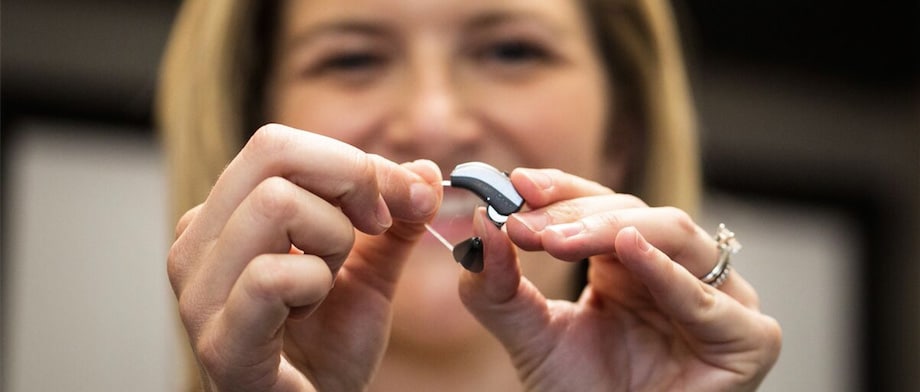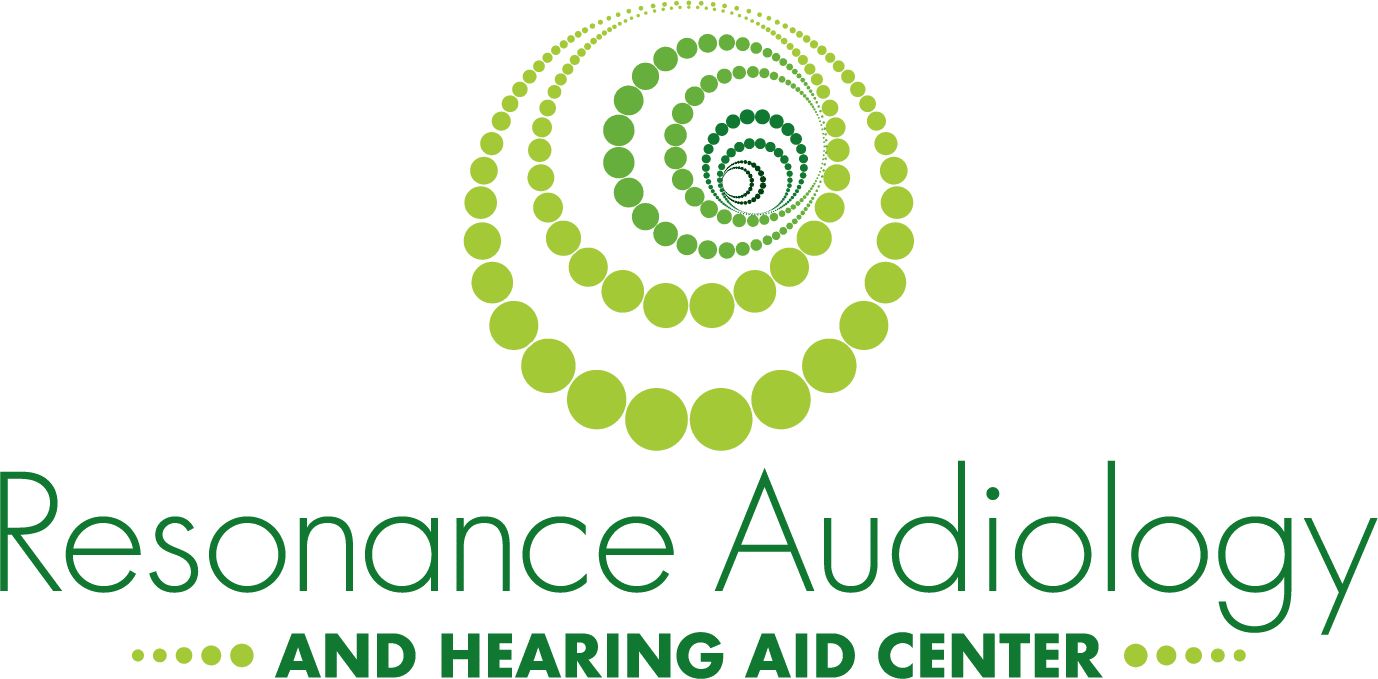
What is a hearing aid?
A hearing aid is a small electronic device that you wear in or behind your ear. It makes sounds louder, so that a person with hearing loss can hear, listen, communicate, and participate more fully in all of their daily activities. A hearing aid may help people hear better in both quiet and in noisy situations.
How can hearing aids help?
Hearing aids are generally helpful because they amplify the sounds in the environment to the specifications a person with hearing loss needs. They are programmed to a prescription that is specific to each person’s hearing loss and may be further adjusted based on their specific needs in every environment that they find themselves in.
Sound is captured by the microphones in the hearing aid and then travels to the analog/digital converter, where the sound is converted from analog to digital. Once digitized, the sound wave can be manipulated to meet the auditory needs of the patient and sent to the digital to analog converter, where the sound is converted back to analog and sent through the receiver or speaker and into the patient’s ear.
How can I find out if I need a hearing aid?
If you think you might have hearing loss and could benefit from a hearing aid, visit an independent and licensed audiologist. An audiologist is a hearing health care professional that diagnoses and treats hearing loss. They will be able to best guide you through the process of determining if a hearing aid is necessary or beneficial for you.
Are there different styles of hearing aids?
Yes, there are many different styles of hearing aids and people with some hearing losses may benefit from one of these styles more than another.
- Behind-the-ear (BTE) hearing aids consist of a hard plastic case worn behind the ear and connected to a plastic ear mold that fits inside the outer ear. The electronic parts are held in the case behind the ear. Sound travels from the hearing aid through the ear mold and into the ear. BTE aids are used by people of all ages for mild to profound hearing loss. A new kind of BTE aid is an open-fit hearing aid. Small, open-fit aids fit behind the ear completely, with only a narrow tube inserted into the ear canal, enabling the canal to remain open. For this reason, open-fit hearing aids may be a good choice for people who experience a buildup of earwax, since this type of aid is less likely to be damaged by such substances.
- In-the-ear (ITE) hearing aids fit completely inside the outer ear and are used for mild to severe hearing loss. The case holding the electronic components is made of hard plastic. Some ITE aids may have certain added features installed, such as a telecoil. A telecoil is a small magnetic coil that allows users to receive sound through the circuitry of the hearing aid, rather than through its microphone. This makes it easier to hear conversations over the telephone. A telecoil also helps people hear in public facilities that have installed special sound systems, called induction loop systems. Induction loop systems can be found in many churches, schools, airports, and auditoriums. Young children usually do not wear ITE aids because the casings need to be replaced often as the ear grows.
- Canal aids fit into the ear canal and are available in two styles. The in-the-canal (ITC) hearing aid is made to fit the size and shape of a person’s ear canal. A completely-in-canal (CIC) hearing aid is nearly hidden in the ear canal. Both types are used for mild to moderately severe hearing loss. Canal aids have less space available for batteries and additional devices, such as a telecoil. They usually are not recommended for young children or for people with severe to profound hearing loss because their reduced size limits their power and volume.
Do all hearing aids work the same way?
Almost all hearing aids today are digital, so the sound processing is essentially the same in each hearing aid, but some allow the audiologist to do more to enhance the sound for your hearing loss and help you hear better in certain environments.
Which hearing aid will work best for me?
The hearing aid(s) that will work best for you are the ones that you will wear and be comfortable with. This is where your audiologist comes in and helps you determine what style of hearing aid will meet your needs and your lifestyle, so you can get the most benefit out of your hearing device and start hearing life again!
It is important to remember that hearing aids will not restore your normal hearing. They will, however, give you the best opportunity to hear in your environments and you should notice a significant improvement with your hearing aids in your ears versus without them.
What questions should I ask my hearing doctor before buying a hearing aid
Before you buy a hearing aid, ask your audiologist these important questions:
- Why should I purchase a hearing aid from you?
- What is the total cost of the hearing aid?
- What features would be most useful to me?
- How long is the warranty?
- Does the warranty cover future maintenance and repairs?
- Are there any charges for making adjustments, servicing and minor repairs?
How can I adjust to my hearing aid?
It sometimes takes time and patience to get used to your hearing aid(s). It is important to wear them as much as you can when you first get them, so your brain can adjust to hearing you and your environment differently. You will likely hear many new sounds you have not heard in years and adjusting to these new sounds may take some time.
Your audiologist should spend significant time with you to practice putting in and taking out the aid, identifying right and left aids, and replacing the batteries and how to clean the hearing aid. It is important to work with your audiologist until you are comfortable with how the hearing aid works and you are happy with how you are hearing life again.
You may experience some of the following problems as you adjust to wearing your new aid:
- My hearing aid feels uncomfortable. Some individuals may find a hearing aid to be slightly uncomfortable at first, as your ear is not used to having a hearing aid on/in it, so it may take a few days to get physically comfortable. It is important to contact your audiologist if you are having some physical discomfort with your hearing aid.
- My voice sounds different. Many people who get hearing aids for the first time or get new ones, feel that their voice sounds much different. There are many reasons for this, but mainly, you are hearing yourself differently due to the fact that your voice is being amplified by the hearing aid, so it is normal for this to happen. Your voice should sound “normal” again in a few days or in as little as a few hours.
- I get feedback from my hearing aid. This has been greatly improved with digital hearing aids and is rarely a concern. If it is, your hearing aid may not be in your ear correctly or your ear could be clogged with wax or debris.
- I hear too much background noise. Hearing aids do not completely shut out background noise and if you feel like you are hearing too much background noise and cannot understand, it is important to schedule an appointment with your audiologist to have your hearing aid adjusted.
How can I care for my hearing aid?
It is extremely important to take good care of your hearing aid(s), as it will improve how well your hearing aid(s) are working and will often improve the life of your hearing aid(s).
- Do the best job you can to keep your hearing aids away from significant moisture and perspiration
- Clean and care for your hearing aids as instructed by your audiologist
- Try to avoid applying hair products while you have your hearing aids in
- Turn off your hearing aid(s) when they are not in use
- Replace batteries in both hearing aids at the same time when one goes bad
- Put your hearing aids in your case or dryer at the end of the day when you go to bed
- Keep your hearing aids away from small children and pets
Call us at (717) 925-6112 and we will be happy to answer any questions you may have or click here to send us a message.
